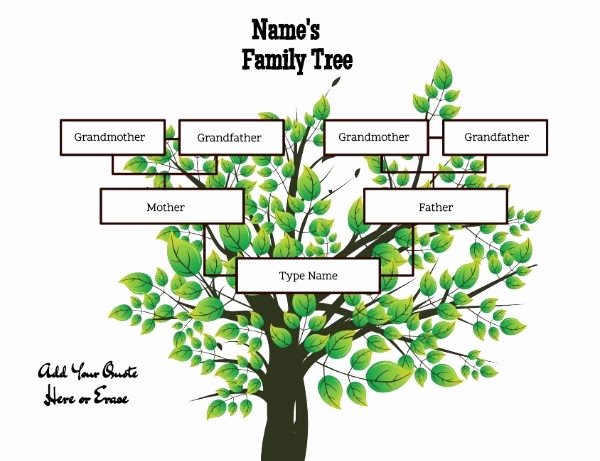

So the root person’s father is 2 and their mother is 3. 1’s father and adds one to that number to get the number for their mother. From there, the system doubles a person’s number to get the number for No. How does the Ahnentafel system work? The root person (say, the genealogist) is assigned the number 1.
#FAMILY TREE MAKER WORD TEMPLATE FREE#
In fact, Family Tree Magazine‘s free five-generation ancestor chart has Ahnentafel numbers built in. The Ahnentafel method is perhaps the most common genealogical numbering system. And von Stradonitz, a German lawyer and genealogist, popularized the Ahnentafel method in his 1898 work Ahnentafel-Atlas: Ahnentafeln zu 32 Ahnen der Regenten Europas und ihrer Gemahlinnen. Sosa, a Spanish Franciscan friar and genealogist, wrote about the method in 1676 in his work Noticia de la Gran Casa de los Marqueses de Villafranca. This Eytzinger Method, known in German as an Ahnentafel (in English, “ancestor table”), was picked up by two later genealogists: Jerónimo de Sosa and Stephan Kekulé von Stradonitz. Austrian historian Michaël Eytzinger published a genealogical work ( Thesaurus Principum Hac Aetate In Europa Viventium) documenting royal European houses in 1590. Keeping track of direct ancestors in a numbering system is reasonably straightforward, so it should not be surprising that the earliest example of such a system can be found more than 400 years ago. You can refer to a traditional family tree (descendancy) view of Elizabeth’s descendants here and more information about William’s here. Note: We’ll demonstrate each system using the genealogy of a famous pedigree, the royal family of the United Kingdom (with Queen Elizabeth II or her grandson William, Duke of Cambridge, as the root person).

They can be divided into three types: ancestral, descendant, and combination. Whether you’re one of those pioneering long-haulers or a beginner genealogist wanting to use an existing system, let’s take a deep dive together into the world of genealogical numbering systems. I wouldn’t be surprised to find a few current genealogists still trying to design a better numbering system, or at least tinkering with existing systems in order to improve them. Numbering could help distinguish two different people with the exact same name, identify which generation they fit into, and even specify the birth order of children within a family.Įven today, using our genealogy software, we still find it helpful to use some of these numbering systems in order to produce lists and reports, especially when sharing with others. As these genealogists began to generate large written family histories or publish their research in the new genealogy journals of the day, they realized they needed some sort of system to number their direct ancestors or the descendants of a famous ancestor. This was the information-management issue studied by some of the best late-19th- and early-20th –century genealogists. And studying the descendants of an ancestor was even more laborious, requiring tracking thousands of individuals. It was especially tricky when multiple ancestors had the same name. Producing large family trees in a visual format demanded tedious work, and figuring out exactly how ancestors might be related to the researcher required large hand-drawn charts and lots of reading. We can even take two people from different parts of our family tree, and a tool will instantly tell us how they are related to each other.īut the pre-computer genealogical world was completely different. Using desktop genealogy software, we can quickly produce lists of ancestors or descendants, search for people with particular names, or display clickable pedigree charts that allow us to move from one person to another.

In our modern digital world, keeping track of our ancestors is relatively easy.
#FAMILY TREE MAKER WORD TEMPLATE HOW TO#
Here’s a brief introduction to genealogical numbering systems, plus how to use the most common (such as Ahnentafel and the Register System). Designed and modified by expert genealogists over decades and even centuries, these systems assign numbers to key family members in your research, making them easier to find and refer to as you build your family tree. If you’re having trouble keeping track of all your ancestors, you might want to use a genealogical numbering system. Family Tree Templates and Relationship Charts.Best Genealogy Websites for Asia and the Pacific.Best Geography and Historical Map Websites.Best African American Genealogy Websites.Best US and Canadian Genealogy Websites.Surnames: Family Search Tips and Surname Origins.Preserving Old Photos of Your Family History.How to Find Your Ancestor’s US Military Records.


 0 kommentar(er)
0 kommentar(er)
